 Life & Style
Life & Style

Have you ever tried eating snakes in Hà Nội?
If you feel brave enough, head to Lệ Mật Village, the most well-known place in Việt Nam to enjoy delicious dishes prepared from snakes raised by locals. Here, you can see and even hold some snakes at the farm before you enjoy a feast of local snake delicacies.
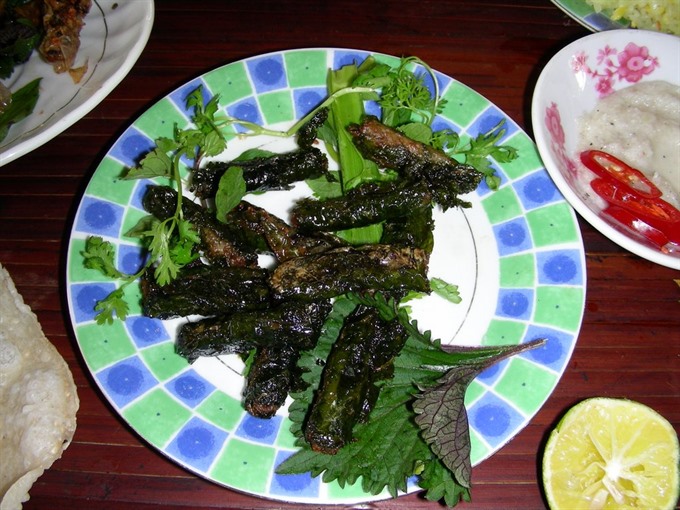 |
| Package: Snake meat wrapped in "lá lốt" leaves. |
By Bạch Liên
Have you ever tried eating snakes in Hà Nội?
If you feel brave enough, head to Lệ Mật Village, the most well-known place in Việt Nam to enjoy delicious dishes prepared from snakes raised by locals. Here, you can see and even hold some snakes at the farm before you enjoy a feast of local snake delicacies.
Lệ Mật is only seven km from Hà Nội’s Old Quarter. After a 30 minute drive, you will find yourself in the ancient village in Việt Hưng ward of Long Biên district, where snake restaurants are abundant.
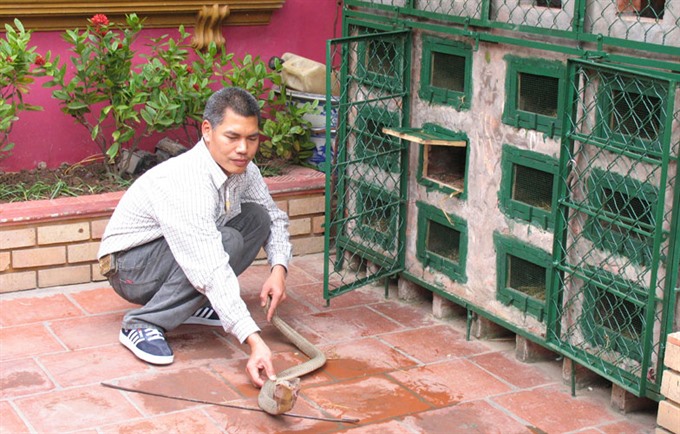 |
| Historic trade: Snake breeding became a Lệ Mật village specialty centuries ago. |
The most popular snakes served in these restaurants are grass snakes and cobras — the cobra is ten times more expensive than grass snakes, of course — and they are all alive.
At the restaurant, you will have the chance to see how your chosen snake is prepared. Its heart and gall are poured into glasses of wine to drink. Other parts of the snake are cooked in different ways to make around ten dishes. Preparation methods include grilling, frying, steaming, wrapping in leaves and even soaking in traditional medicine.
Snake alcohol is quite popular because it is believed to be good for one’s health.
Trương Khắc Lập, owner of the village’s Rắn Ráo restaurant, is proud of his restaurant, which has been open for 20 years.
“Our customers can choose the live snakes in our farm. Then we will prepare dishes from those snakes following their demands,” he said.
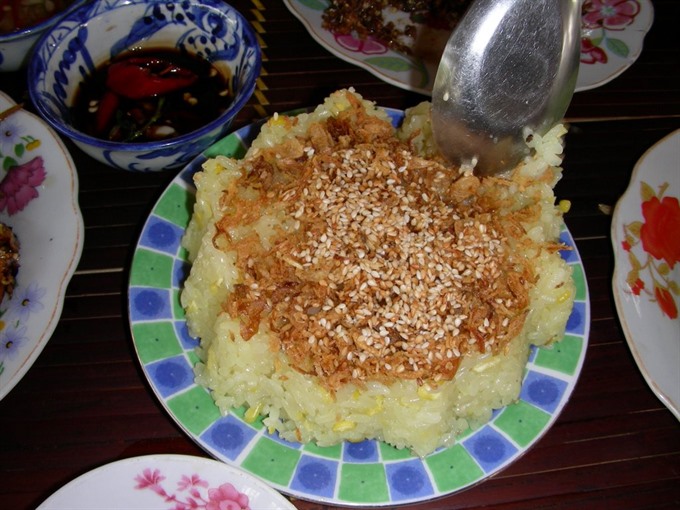 |
| Sticky: Glutinous rice cooked with snake grease. |
At first, visitors to the restaurant “were overwhelmed with their fear of snakes.” So the restaurant prepared the snakes out of sight to avoid scaring the already anxious clients.
Snake meat, he said, is quite similar in taste and texture to eel meat. Popular dishes include stir-fried crispy snake skin, pan-fried backbone with rice crackers, snake with fried vermicelli, snake wrapped in lá lốt leaf, snake soup and snake spring rolls.
Adventurous diners can taste snake wine, which is rice wine mixed with blood and heart of the snake.
“It is very good for health, supporting immune function and bone health. Snake wine is especially good for male sexual vitality,” he explains. “We have more and more people coming here to visit snake farms and enjoy the many snake meats, not just for the taste, but also the considerable health benefits.”
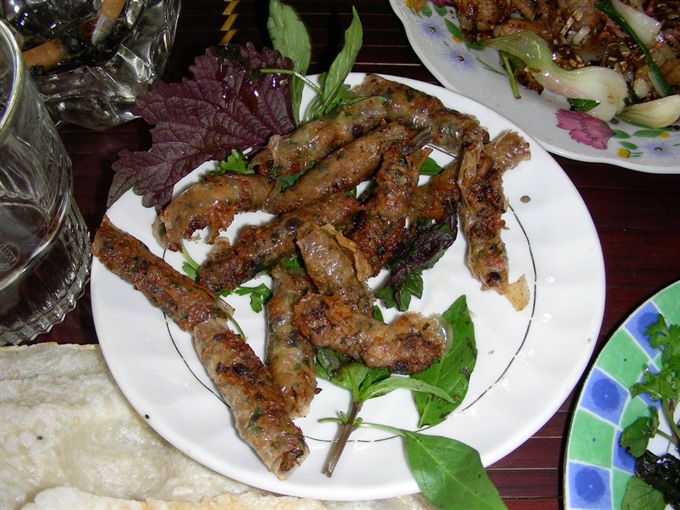 |
| Fried: Spring rolls made with snake meat. |
No one knows exactly when villagers in Lệ Mật began to breed snakes. But for centuries, they have told each other a legend explaining the origin of the job.
Legend has it that one day while the daughter of King Lý Thái Tông (1072-1127) was on a pleasant boat cruise with her maids on the Đuống River, a big snake, which was considered a water monster, overturned the boat and caught the princess.
The crew could do nothing to protect the unfortunate princess. But a young man in the Hoàng Family from Lệ Mật Village dove into the water, fought against the monster and, in the end, succeeded in killing it and saving the princess.
King Lý Thái Tông was deeply impressed by the young man’s feat and gave him a reward of gold and court titles. But the hero graciously rejected the reward and, instead, requested the King allow him and a number of poor people to reclaim land in the areas west of the capital in Thăng Long.
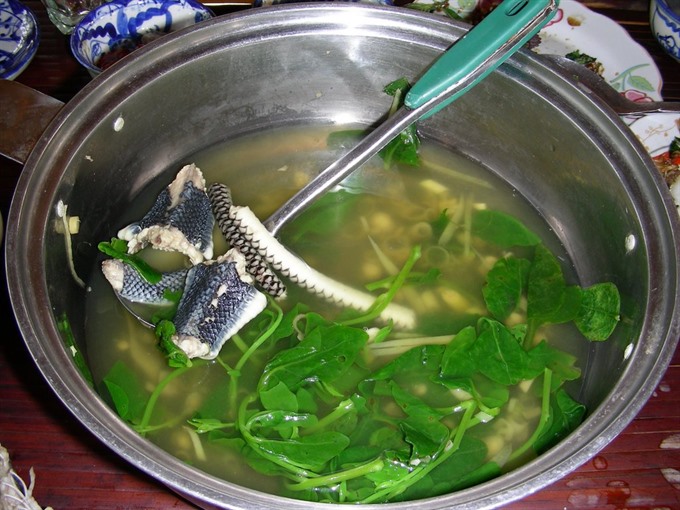 |
| Swimming: Snake soup |
As the King gave his assent, the young man led the poor to reclaim their land and established 13 prosperous and famous agricultural settlements in the neighbourhood of Thăng Long. When the man passed away, the locals honoured him as the village’s tutelary god and every year organize a festival to commemorate him.
Following the example of the man, inhabitants in Lệ Mật began to breed snakes.
Lệ Mật Village Festival consists of many unique rites and folk activities, such as the water offering ceremony, the snake killing dance – one of the ten ancient dances in the imperial capital of Thăng Long—and the rite of catching carp.
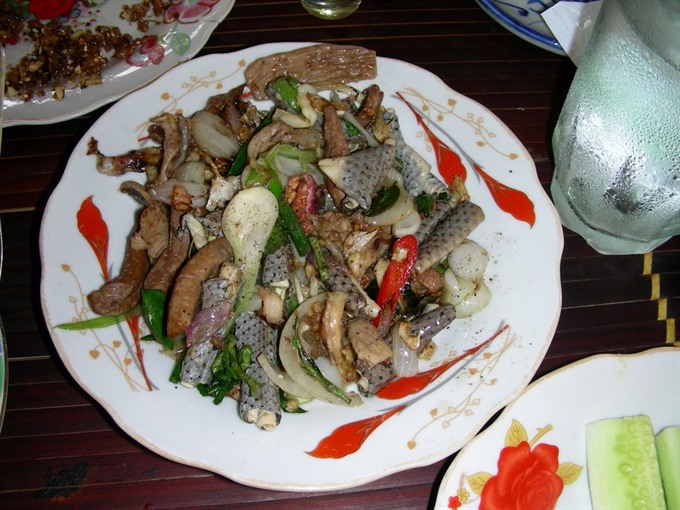 |
| Also fried: Fried snake, one of the most popular snake dishes in Lệ Mật village. |
There are roughly 100 snake-farming households in Lệ Mật.
It is hard to believe that not long ago, the business of snake breeding and meat production almost disappeared. From the 1960s to 1990s snakes around Lệ Mật were bred for restaurants and pharmaceutical purposes.
Then, in 1993, Việt Nam ratified the international convention on the protection of wildlife and imposed restrictions on the snake-breeding industry. Snake meat disappeared from menus. In 2007, aware of the negative repercussions on the local dining economy, Vietnamese authorities granted Lệ Mật ‘craft village’ status. On this basis plans for development were drawn to turn snake breeding and meat production into an experience that would be popular with tourists eager to sample this most unique Vietnamese specialty.
If you are brave enough to experience meat, just jump on city Bus No. 10 to Long Biên Bus Station and walk a few hundred metres to Lệ Mật village.— VNS




.jpg)